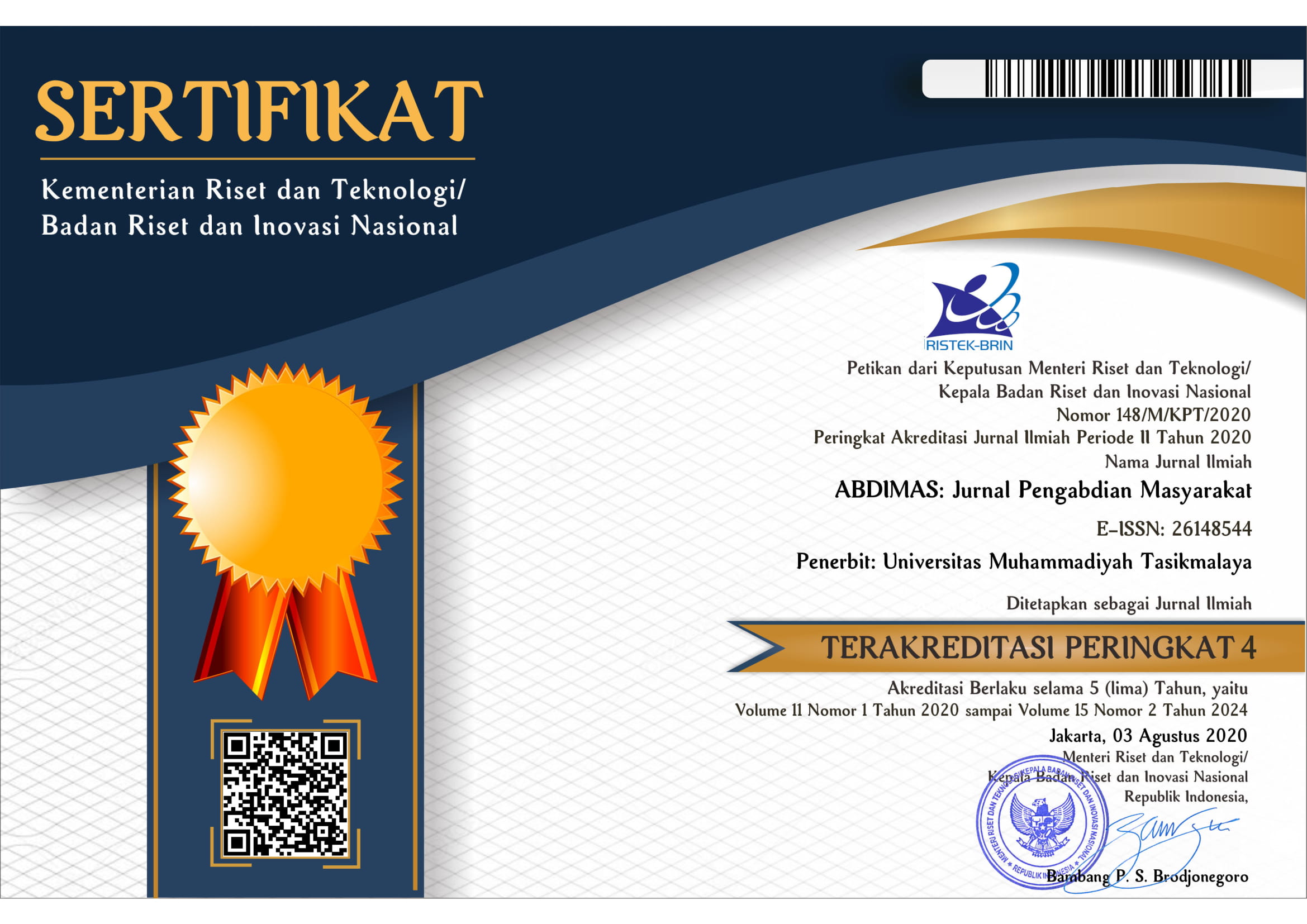Implementation of Health Belief Models (HBM) Education for Tuberculosis patients at the Tamansari Primary Health Care, Tasikmalaya City
DOI:
https://doi.org/10.35568/abdimas.v4i2.1120Keywords:
Education, Health Belief Models, TuberculosisAbstract
Tuberculosis (TB) is an infectious disease that continues to increase not only nationally but also globally. Tuberculosis is a problem for sufferers both physically and psychologically, it can even cause negative stigma from themselves and society, so the disease affects the quality of life of the sufferer. Tuberculosis treatment that is long enough and requires compliance can cause susceptible to drop out (DO), finally will increase the risk of cases of Multi Drug Resistance (MDR). The role of nurses is needed in ensuring tuberculosis patient adherence in treatment. Patient will be understand that tuberculosis is important in the treatment process. Education is a strategy in increasing patient understanding to change positive behavior for tuberculosis sufferers. The aim of this community service is to implement Health Belief Models (HBM) Education in Tuberculosis patients. This method used lectures, interviews and practice. The results found that the implementation of HBM on 19 patients who visited Tamansari primary health care for 3 months showed a significant result in behavior and quality of life. HBM education can change the quality of life of tuberculosis sufferers by changing perceptions of the disease which includes perceptions of vulnerability, perception of severity, perceived benefits, perceptions of barriers and a person's belief in healthy behavior. It is recommended that HBM education should continue to be implemented for tuberculosis sufferers so that they can maintain their survival.
Downloads
References
Asuquo, A. E., Pokam, B. T., Adindu, A., Ibeneme, E., & Obot, V. (2014). Health-Related Quality of Life (HRQoL) of Tuberculosis (TB) Patients in Akwa Ibom State, Nigeria. Journal of Tuberculosis Research, 02(04), 199–206. https://doi.org/10.4236/jtr.2014.24024
Dhuria, M., Sharma, N., & Ingle, G. (2008). Impact Of Tuberculosis On The Quality Of Life. India. Indian Journal Of Community Medicine: Official Publication Of Indian Association Of Preventive & Social Medicine, 33(1), 58.
Elgzar, W. T., Al-Qahtani, A. M., Elfeki, N. K., & Ibrahim, H. A. (2020). Covid-19 outbreak: Effect of an educational intervention based on health belief model on nursing students’ awareness and health beliefs at najran university, kingdom of saudi arabia. African Journal of Reproductive Health, 24(2 Special Edition COVID-19), 78–86. https://doi.org/10.29063/ajrh2020/v24i2s.12
Falah, M., Tai, C.-Y., Lu, Y.-Y., Liu, C.-Y., & Lismayanti, L. (2019). Tuberculosis Knowledge among University Students in Indonesia. South East Asia Nursing Research, 1(2), 95. https://doi.org/10.26714/seanr.1.2.2019.95-105
Ghanbary, M. K., Shamsi, M., Khorsandi, M., Farazi, A., Ranjbaran, M., & Eshrati, B. (2015). Effect Of Training With Teaching Methods Designed Based On Health Belief Model On Knowledge And Self-Efficacy In Nurses On The Disciplines Standard Precautions In Hospitals. Journal Of Human Health, 1(2), 51.HamidReza, Z. T., Hamid, C. Z., Mahmud, A., & Mohsen, N. (2013). The effect of intervention based on health belief model on improving the quality of life in patients with multiple sclerosis. Life Science Journal, 10(SUPPL.4), 84–89.
Hamidreza,Z, Hamid, C., Mahmud, A., Mohsen, N., 2013. The Effect Of Intervention Based On Health Belief Model On Improving The Quality Of Life In Patients With Multiple Sclerosis . Life Science Journal, (ISSN: 1097-8135). Http://Www.Lifesciencesite.Com[6 April 2016].
Jackson, S., Sleigh, A. C., Wang, G. J., & Liu, X. L. (2006). Poverty and the economic effects of TB in rural China. International Journal of Tuberculosis and Lung Disease, 10(10), 1104–1110.
Jadgal, K., NakhaeiMoghadam, T., AlizadehSeiouki, H., Zareban, I., & SharifiRad, J. (2015). Impact of Educational Intervention on Patients Behavior with Smear-positive Pulmonary Tuberculosis: A Study Using the Health Belief Model. Materia Socio Medica, 27(4), 229. https://doi.org/10.5455/msm.2015.27.229-233
Kemenkes. (2015). Rencana Aksi Nasional ProgrammaticManagement of Drug Resisteance Tuberculosis Pengendalian Tuberkulosis Indonesia 2011-2014. kemenkes RI.
Kurniasih, I. E. (2019). Pengaruh Health Education Audiovisual Berbasis Health Belief Model (Hbm) Terhadap Perilaku Kepatuhan Pasien Tuberkulosis (Doctoral Dissertation, Universitas Airlangga).
Lismayanti, Sari. (2017). Pengaruh Edukasi Health Belief Model Terhadap Kualitas Hidup Penderita Tuberculosis Di Pkm Tamansari Kota Tasikmalaya. Universitas Muhammadiyah Tasikmalaya, May 2018. https://www.researchgate.net/publication/325439155_PENGARUH_EDUKASI_HEALTH_BELIEF_MODEL_TERHADAP_KUALITAS_HIDUP_PENDERITA_TUBERCULOSIS_DI_PKM_TAMANSARI_KOTA_TASIKMALAYA
Morris, M. D., Quezada, L., Bhat, P., Moser, K., Smith, J., Perez, H., Laniado-Laborin, R., Estrada-Guzman, J., & Rodwell, T. C. (2013). Social, economic, and psychological impacts of MDR-TB treatment in Tijuana, Mexico: A patient’s perspective. International Journal of Tuberculosis and Lung Disease, 17(7), 954–960. https://doi.org/10.5588/ijtld.12.0480
Pamela Sari, N., & Rachmawati, A. S. (2019). Pendidikan Kesehatan Tuberkulosis “TOSS TB (Temukan Obati Sampai Sembuh).” ABDIMAS: Jurnal Pengabdian Masyarakat, 2(1), 103–107. https://doi.org/10.35568/abdimas.v2i1.338
Patricia, N. B., . D., & . S. (2020). Efek Pemberian Edukasi Health Belief Model Pada Penderita Tuberkulosis Paru Terhadap Pengetahuan Dan Persepsi Kepatuhan Pengobatan. Gema Lingkungan Kesehatan, 18(1), 68–73. https://doi.org/10.36568/kesling.v18i1.1214
WHO. (2015). Digital Health for the End Tb Strategy: an Agenda for Action. Who, 24. https://www.who.int/cancer/en/
World Health Organization. (2018). Compendium of WHO guidelines and associated standards: ensuring optimum delivery of the cascade of care for patients with tuberculosis. In World Health Organization (Issue June). https://apps.who.int/iris/bitstream/handle/10665/272644/9789241514101-eng.pdf?ua=1














